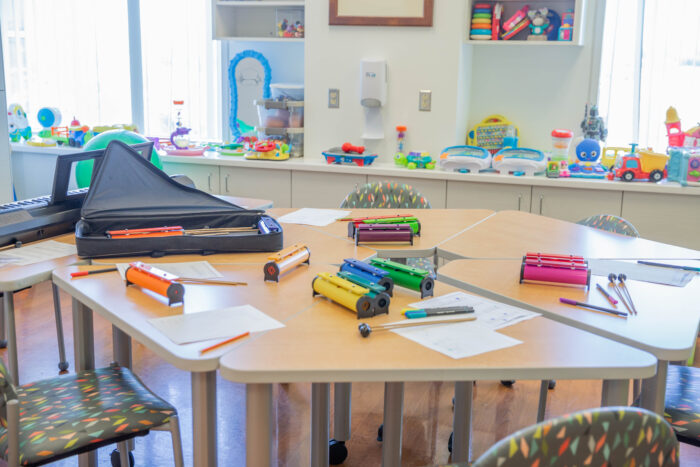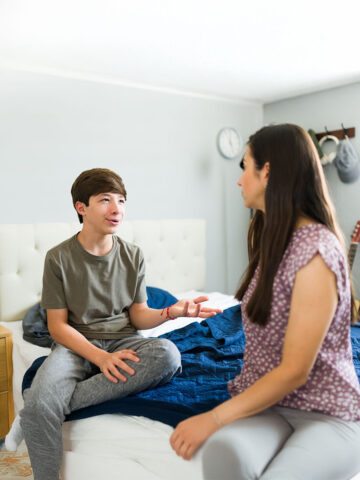For many families, listening to or making music can offer a way for relaxation, remembering special moments or having top-notch dance parties.
However, what some may not realize is the powerful role that music can play in feeling and expressing emotions, improving communication, healing and much more.
Brooke Sinang, a licensed music therapist at CHOC at Mission Hospital, orks with the interdisciplinary treatment team to provide music therapy programming and services for patients and families. She works primarily with CHOC’s Eating Disorders Program but also receives referrals for music therapy services in all areas of the hospital.
Music therapy is just one of the specialized therapeutic programs offered through the Cherese Mari Laulhere Child Life Department at CHOC.
Here, Brooke explains the benefits of music therapy for kids and teens and how parents can add music into their child’s daily routine to promote mental wellness.
What is music therapy?
The American Music Therapy Association defines music therapy as the clinical and evidence-based use of music interventions to accomplish individualized goals within a therapeutic relationship by a credentialed professional who has completed an approved music therapy program.
Brooke defines music therapy as the therapeutic use of music to meet a child’s mental, physical, emotional and spiritual needs.

Typical music interventions can include music listening, lyric analysis, musical re-creation, music improvisation and songwriting, says Brooke. Instruments range from drums, shakers, keyboards, ukulele, guitar, hand bells and other percussion instruments. The patient does not need music experience, and the music therapist adapts the interventions to match each patient’s abilities, preferences, and needs.
How can music be used at home for mental wellness and to help kids cope?
Although a board-licensed professional must lead music therapy, parents can use a variety of ways to incorporate music into their family’s routines at home.
Music can be a great way to connect with your child; you don’t need any musical instruments and fancy supplies to listen to or make music together.
Brooke offers the following activities that can help your child express their emotions and cope through music:
- Get to know your child’s favorite musical artists and then listen to them together. Ask them what they like about it about the music. Is it the instruments? Lyrics? The beat?
- Sing, clap, and dance together. Even if you think you can’t sing or dance, your child will love that time together making music.
- Create a wellness or coping playlist together using your child’s favorite music to utilize when they need relaxation or a calming environment. Choosing each song with intentionality is an excellent way to get to know your child and find what types of music help them relax and cope.
- Listen to music on a phone or with speakers. “I like putting my phone inside a cup to amplify the sound!” Says Brooke.
- With younger kids, make shakers by putting beans and/or rice inside a paper towel or toilet paper roll and taping it closed. Then your child can use their new shaker to play along with a favorite song.
- Play freeze dance. Take turns letting your child play or controlling the music. You can “freeze” when the music stops.
- With older kids, print out lyrics from their favorite songs and have them cut out the lyrics that stand out most to them. Then, your teen can arrange the lyrics to create a poem and hang it in their room for daily inspiration.
How can music therapy help children?
Music can help a child express themselves in a non-verbal way that can be less threatening than responding with words, helping them gain personal insight that is crucial when recovering from surgery or illness.
“When a child, adolescent, or teen is admitted to the hospital, they may feel anxious, isolated, sad, or angry. At CHOC, music therapists help patients regain a sense of control and normalize their environment, supporting them as they cope. In group sessions, therapists create a ‘no judgment zone’ to remind patients there is no right or wrong way to express themselves through music. “All feelings are OK” is also a mantra that Brooke uses to encourage patients that there are no good or bad feelings or music.

Music therapy is typically offered in both individual and group formats to help patients with self-regulation, coping skills, emotional expression, enhanced mood, social interactions, attention and focus Music therapists use their clinical skills in the assessment, treatment and planning of music therapy interventions that benefit a wide range of ages and abilities — with no music experience needed!
Beyond the hospital, music therapy interventions can address a variety of mental health goals like promoting wellness and relaxation, managing stress, alleviating pain, helping express and identify feelings, enhancing memory, improving communication and socialization and more.
In what ways does music therapy differ from music education?
Music therapy and music education have different goals, says Brooke. Music education’s goals are primarily to help others effectively perform music, read music, learn notation, techniques, and history, etc.
In contrast, music therapy’s goals are non-musical in nature. A child may learn how to play an instrument and even perform music for others in a music therapy session. However, the process in which they are learning will be therapeutic in nature. Music therapy uses music as the tool to meet or achieve non-musical goals such as building self-esteem, increasing socialization and communication, etc. Contrary to music education, music therapy holds the process as equal value to the result.
Learn more about CHOC’s specialized therapeutic programs
The Cherese Mari Laulhere Child Life Department at CHOC strives to normalize the hospital environment for patients and families.





